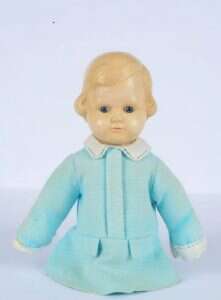Miriam (Frumer) Ressler called her childhood memento, "my little doll." Out of all her treasured possessions, the 5-year-old chose to take this doll with her as her family fled the small Slovakian town of Michalková and began their journey into the unknown.
The family was forced to flee once it became known that Slovakian Jews would be sent to the death camps. Miriam was born in 1937 to Moshe and Olga Ressler and had two other sisters. For three years, the family managed to evade being sent to the camps, often spending time hiding in desolate forests and remote villages.
Follow Israel Hayom on Facebook and Twitter
For example, a couple by the name of Vincent and Anna Tekley hid the family in their wine cellar. One day, German soldiers discovered the cellar and began firing at it indiscriminately. The Russell family survived that shooting and then went on to find refuge by hiding under the floor of a farmer's barn – accommodations they paid a handsome fee for.
After the farmer and his wife learned the Resslers were running out of money, they reported the family to the authorities. The couple offered to wash the family's clothes – including the doll's tiny garments – but in actuality, called up the Slovakian guards to notify them of the family's existence. The guards seized the family and detained them until they were ready to be sent to the camps for what would be their inevitable death.
However, thanks to luck and cunning on the Resslers' part, they were able to escape their confinement. They returned to the couple who owned the wine cellar and hid there until the end of the war.
And what of the doll? The doll was left behind in the farmhouse, likely never to be seen again.

While hiding under the floor in the farmhouse, Miriam believed the doll protected her and her family during those horrible and harrowing days.
Once Slovakia was liberated, her parents pleaded and wept with the farmers for the doll to be returned to Miriam.
"It was only a doll, but I felt she gave me strength. When my whole body would shake from fright, I'd hug the doll close to me and she'd calm me down. I spoke to her. I sang to her. She was everything to me," Ressler said.
The family found the doll among the farmer's possessions – broken, with no arms and legs.
In 1947, the Ressler family immigrated to Israel. Vincent and Anna Tekley were recognized by Yad Vashem as Righteous Among the Nations – an honor bestowed on non-Jews whose kindness and generosity allowed some Jews to survive the Holocaust.
Later, Miriam married the late Moshe Eli Farmer in Israel, and they have two daughters. Today she has six grandchildren and a 1½ year-old great-grandson.
Despite all the time that has elapsed, the decision to hand the precious doll to Yad Vashem was not easy.
Michael Tal, director of the Yad Vashem Collection, explained, "During the Holocaust, people had to say goodbye to their belongings. In many cases, they had one object that became a world to them and gave them hope. Yad Vashem is using these objects to tell the story of the survivors, who in a few year's time will no longer be with us."
"I was debating whether to give the doll to Yad Vashem and say my final goodbyes," she said. "I felt that this doll protected me and was my best friend. To this day I think of her. In the end, we decided it was the best place so they wouldn't forget what we went through in the Holocaust. After I am no longer here, she will continue to tell my story."
The doll is part of the new online exhibition, Children in the Holocaust which appeared on the Yad Vashem website, in which various stories of children in the Holocaust are displayed through personal items. The doll was given to Yad Vashem as part of the "Gathering the Fragments" project to collect personal items from the Holocaust period.
To coordinate and deliver items as part of the "Gathering the Fragments" project call: 972-2-6443888, collect@yadvashem.org.il




